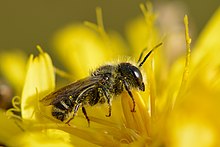Megachile
[2] The alfalfa leafcutter bee (Megachile rotundata) is managed on a commercial scale for crop pollination, and has been introduced by humans to various regions around the world.
Nests are sometimes constructed within hollow twigs or other similarly constricted natural cavities, but often are in burrows in the ground.
Numerous families of wasps and bees parasitize Megachile nests, including Gasteruptiidae, Leucospidae, Sapygidae, and various kleptoparasitic megachilids, such as the closely related genus Coelioxys.
[1] Various species in the genus, especially those in the subgenus Chalicodoma and related groups, do not use cut leaves to line the cells, but instead use fairly dry plant resin, which they carry in their mandibles.
Some Megachile species have no lobe (arolia) between their claws, thus are unable to climb smooth walls or glass.
